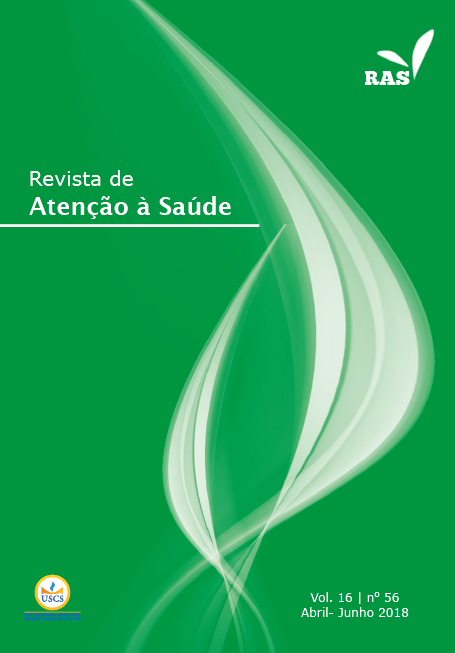INVOLVED SYMPTOMS, FOOD CONSUMPTION, AND NUTRITIONAL STATUS IN UNIVERSITY WOMEN DURING THE MENSTRUAL PERIOD
DOI:
https://doi.org/10.13037/ras.vol16n56.4591Keywords:
Premenstrual syndrome, food intake, women, quality of lifeAbstract
Aim: Relating the symptoms of the premenstrual period with dietary intake and nutritional status in university women of Guarapuava, Paraná, Brazil. Methods: This was a cross-sectional study with 141 women aged between 20 and 42 years. Data collection was conducted with a questionnaire containing demographic information, symptoms related to premenstrual syndrome (symptom frequency, duration, intensity, symptoms that have a greater impact on the woman’s day-to-day), anthropometric and food consumption data. The results were expressed through descriptive statistics and tests. Results: The mean age was 23.74±4.76 years, 65.2% (n=92) of the participants were classified as normal weight, most reported having behavioral changes during the premenstrual period, and 47% (n=67) reported being dissatisfied with their body image, 89.3% (n=126) had insomnia, 84.3% (n=119) had irritability. and 83.6% (n=118) experienced emotional instability. Regarding feeding behavior, 62.4% (n=88) of the participants had increased appetite. The foods most consumed daily throughout the menstrual period were cereals 92.2% (n=130), candy 41.1% (n=58), and chocolate 35.5% (n=50). Conclusion: Face the premenstrual symptoms reported by university women in this research, it is possible to conclude that there were changes in food consumption. There was no change in the nutritional status because not all the changes in the premenstrual period influence body composition alterations. Thus, it is necessary that Nutrition professionals are always attentive to these food consumption changes, to properly guide them to a healthy diet and to ensure adequate nutritional status and quality of life for university women.
Downloads
References
Approbato MS, Silva CDA, Perini GF, Miranda TG, Fonseca TD, Freitas VC. Síndrome pré-menstrual e desempenho escolar. Rev Bras Ginecol Obstet. 2001;23(7):459-62.
Montes RM, Vaz CE. Condições afetivo-emocionais em mulheres com síndrome pré-menstrual através do z-teste e do IDATE. Rev Pis: Teor e Pesq. 2003;19(3):261-7.
Valadares GC, Ferreira LV, Correa FH, Romano SMA. Transtorno disfórico pré-menstrual - revisão – conceito, história, epidemiologia e etiologia. Rev Psiquiatr Clín. 2006;33(3):117-23.
Maia Ms, Aguiar MIF, Chaves ES, Rolim ILTP. Qualidade de vida de mulheres com tensão pré-menstrual a partir da escala WHOQOL-BREF. Rev Cienc Cuid Saúde.2014;13(2);236-44.
Carvalho VCP, Cantilino A, Carreiro NMP, Sá LF, Sougey EB. Repercussões do transtorno disfório pré-menstrual entre universitárias. Rev Psiquiatr. 2009;31(2)105-11.
Sampaio HAC. Aspectos nutricionais relacionados ao ciclo menstrual. Rev Nutr. 2002;15(3):309-17.
Teixeira ALS, Oliveira ECM, Dias MRC. Relação entre o nível de atividade física e a incidência da síndrome pré-menstrual. Rev Bras Ginecol Obstet. 2013;35(5):210-4.
Silva CML, Gigante DP, Carret MLV, Fassa ACG. Estudo populacional de síndrome pré-menstrual. Rev Saúde Pública.2006;40(1):47-56.
Azevedo MRD, Saito MI, Berenstein E, Viedas D. Síndrome pré-menstrual em adolescentes: um estudo transversal dos fatores biopsicossociais. Rev Arq Med ABC. 2006;31(1):12-7.
Paiva SPC, Paula LB, Nascimento LLO. Tensão pré-menstrual (TPM): uma revisão baseada em evidências científicas. Rev Fem. 2010;38(6):311-5.
Costa YR, Fagundes RLM, Cardoso RB. Ciclo menstrual e consumo de alimentos. Rev Bras Nutr Clin. 2007;22(3):203-9.
Rodrigues IC, Oliveira E. Prevalência e convivência de mulheres com síndrome pré-menstrual. Rev Arq Ciênc Saúde. 2006;13(3):XX-XX.
World Health Organization. Obesity: preventing and managing the global epidemic; Report of a WHO consultation. World Health Organization Technical Report Series, 894:1-253, 2000.
Oliveira DR, Bicalho AH, Davis LG, Davis PS, Brito DAA, Santos LC. Síndrome pré-menstrual e aspectos relacionados à antropometria e ao comportamento alimentar. Rev O Mundo da Saúde. 2013;37(3):280-7.
Glaner, M. F. Composição corporal em diferentes períodos do ciclo menstrual e validade das técnicas antropométricas e de impedância. Rev, Paul Educ Fís. 2001;15(01):5-16.
Reed SC, Levin FR, Evans SM, Changes in mood, cognitive performance and follicular phases of the menstrual cycle in women wigh and without PMDD (premenstrual dysphoric disorder). Hormon Behav. 2008;54:185-93.
Santos AS, Soares C, Dias ACH, Penna N, Castro AOS, Azeredo VB. Estado nutricional e consumo alimentar de mulheres jovens na fase lútea e folicular do ciclo menstrual. Rev Nutr. 2011;24(2):323-31
Silva SMCS, Mura JDAP. Tratado de alimentação, nutrição e dietoterapia. 2ed. São Paulo: Roca; 2010.
López LM. Aspectos nutricionais e metabólicos na tensão pré-menstrual [tese]. Rio Grande do Sul (RS): Universidade Federal do Rio Grande do Sul; 2013.
Zanini RV, Muniz LC, Schneider BC, Tassitano RM, Feitosa WMN, Chica DAG. Consumo diário de refrigerantes, doces e frituras em adolescentes no Nordeste brasileiro. Rev Ciência & Saúde Coletiva. 2013;18(12):3739-3750.
Maramatsu CH, Vieira OCS, Simões CC, Katayama DA, Nakagava FH. Consequências da síndrome da tensão pré-menstrual na vida mulher. Rev Esc Enferm. 2001;35(1):205-13.
Chemim SM, Silva S, Fernanda B, Silva C, Farina BV, Spinoza ED et al., A influência da tensão pré-menstrual sobre os sintomas emocionais e o consumo alimentar. Rev Soc Bras Alim Nutr. 2012;37(1):13-21.
Tribess S, Junior JSV, Petroski EL. Estado nutricional e percepção da imagem corporal de mulheres idosas residentes no nordeste do Brasil. Rev Ciências & Saúde Coletiva. 2012;15(1):31-38.
Downloads
Published
Issue
Section
License
Policy Proposal for Journals offering Free Delayed Access
Authors who publish in this magazine agree to the following terms:
- Authors maintain the copyright and grant the journal the right to the first publication, with the work simultaneously licensed under a Creative Commons Attribution License after publication, allowing the sharing of the work with recognition of the authorship of the work and initial publication in this journal.
- Authors are authorized to assume additional contracts separately, for non-exclusive distribution of the version of the work published in this magazine (eg, publishing in institutional repository or as a book chapter), with the acknowledgment of the authorship and initial publication in this journal.
- Authors are allowed and encouraged to publish and distribute their work online (eg in institutional repositories or on their personal page) at any point before or during the editorial process, as this can generate productive changes, as well as increase impact and citation of the published work (See The Effect of Open Access).









